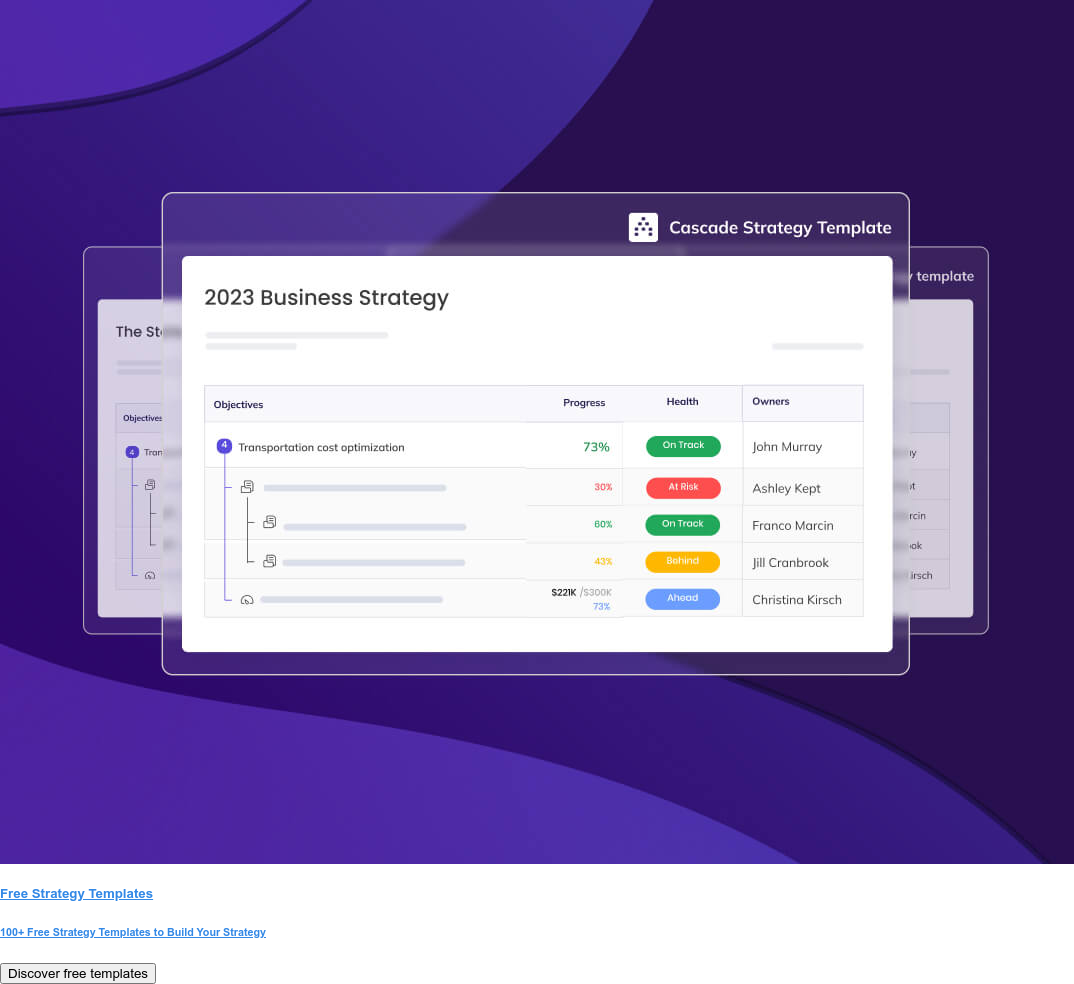One of the most rewarding parts about being in business is building a team of people that are all working towards the same vision and mission and seeing that come to manifest itself. Running a business, especially in a competitive environment, is especially hard- so the reward of long-term alignment and a common goal achieved is one of the most incredible moments and feelings that any of us could experience.
But humans are complicated, and running a business where everyone has different ideas, viewpoints, and opinions makes it very difficult to find that common purpose and align everyone on the same path. Even though we know that this is a crucial piece of success, it’s something that we can often shy away from because it is challenging to accomplish.
It’s much easier to step up to our mantle as decision-makers and dictate the strategy from the top, hoping that our authority and status in the company will help our plans cascade down the hierarchy. It’s the path of least resistance. But, as Ilana Rosen described so eloquently in her talk at the 2021 Cascade Strategy Fest, we have to be braver than that.
We have to co-create company strategy.
“When you co-create strategy, strategy itself can become a change management tool.” - Ilana Rosen
Luckily, Ilana left us with an incredible 6-point game plan for co-creating strategy in our organizations and so we thought we’d expand on it here.
1. Discovery
The most important step of true co-creation is to empower your people to actually be a part of the solution. You want every member of your organization to be invested in the vision and the way you do this is by letting their voice be heard. Discovery, as Ilana calls it, refers to the simple act of listening to and understanding what your organization is feeling right now.
Just because it’s simple though, doesn’t mean it’s easy. And that’s why so many companies shy away from this. Instead, they prefer to pay external consultants large sums of money to come in and provide insights into the organization. In doing so, they miss out on a huge opportunity internally. There is a significant amount of wisdom and insight sitting in the heads of your employees if only you could extract it. And these employees are best placed to assist because of their proximity to the actual customer themselves.
Discovering what your employees think and giving their ideas time to be heard is something that you should be doing continually, day after day if you want to build an aligned organization. But in strategic situations, it’s even more important because they can give you the reality check that you need if you’re too far removed from what’s happening on the ground.
These insights are not just going to come to you. You need to be actively engaging with the talent that fuels your organization. By leveraging their experiences, you can keep your finger on the pulse of how your organization is running and then use a bird' eye view to put the right changes into action.
This is a big part of what we’re trying to do here at Cascade. We aim to help organizations align themselves with all team members and encourage the sort of communication and collaboration that is at the foundation of any strategic co-creation. This sort of discovery is crucial for understanding the intricacies of the team that you have assembled, and without this your strategy is likely to fall upon deaf ears.
By putting effort into discovery, you are empowering your people to dream and plan along with you. You allow them to see the impact that their hard work is going to have. And your alignment can drive towards long-term business success. Listen first, then talk.
2. Yes, and?
Ilana’s next point actually comes from the world of improvisational theatre which made it so fascinating for us when we heard it. But it soon became clear that this principle can be a game-changer for elucidating the creativity and open-minded brainstorming that your organization might be missing as it considers its strategic direction.
In improvisational theatre, you are making up the story as you go along. You are co-creating a performance in a fictional world and if you aren’t able to collaborate and compromise- you’re going to run out of steam. So, the tactic they teach is something called ‘Yes, and?’.
The idea is that when someone makes a decision on stage, regardless of whether you think it’s a promising one or not, you go along with it. You say yes. If you were to cut them down at that moment because you thought that they should have gone in a different direction, then you’d kill the momentum of the scene and the trust of your other team members. Instead, you say yes, and then you add to it. You build on what they have given to you.
It’s a simple trick, but its revolutionary in the early stages of idea generation because it doesn’t kill premature ideas but encourages everyone to keep building on whatever is brought up, just to see where it goes.
This is incredibly relevant for business as well when you’re trying to create a safe environment for people to raise their voices and share ideas. The moment you stomp on someone’s idea, you break that trust and they’re likely to hold things back in the future. On the other hand, if you can use the ‘Yes, and?’ principle to accept their idea and see how you can build on it- then you encourage them to keep contributing.
This is not to say that you have to go along with obviously bad ideas. But in the early stages of brainstorming and co-creation, you have to accept that it’s going to take 100 bad ideas to find the one golden one. By creating the psychological space where new thoughts are welcomed, no matter how fully formed they are, you nurture those great ideas that are hiding behind fear. Realism and practicality can come later.
You simply have no idea what you’re missing out on when you shut people down too early.
3. Time-Bound Activities
There is, of course, a danger of letting unfettered brainstorming cause things to be dragged out far beyond what is reasonable. At some point, you actually have to be decisive. A strategic plan is not useful until it is executed and so there needs to be a line in the sand where the brainstorming ends and an action plan begins.
This is a difficult step because natural perfectionism can creep in as we try to plot the perfect path towards our inevitable success. We think that if we could just do a little bit more research, we’d find that golden ticket we’ve been looking for. We delude ourselves into thinking that we could create the perfect plan that anticipates all possible outcomes.
It’s just not true. The world is too uncertain. And the future is too uncertain.
And so, we have to bound ourselves. Finished is better than perfect, and the only way we can enforce that in a space of co-creation is to create boundaries around which we cannot cross. Ilana recommends that every strategy session has a very strict start and stop time that serves as a deadline for us to come up with something.
This simple operating procedure helps us to avoid analysis paralysis where every new piece of information or idea sends us down yet another rabbit hole. We need to find a balance between open-ended idea generation and the more practical execution plan. Ideally, you want to come out of these sessions with something that you can test. If you have a hypothesis and a game plan – you can actually test your assumptions in the market and get real feedback that is much more valuable than any market research.
Once you have that feedback, you iterate and you learn as you go. Every iteration shifts your plan and slowly makes incremental progress towards where you want to go. This way of doing things is much more powerful than trying to have a perfect plan from the get-go. So, not only should your strategic planning sessions have time-bounds, but your in-market tests should have time-bounds.
Say, for example, you want to bring a new product to the market but you’re unsure of how to position it. You might decide that you’re going to spend 2 months on ‘Plan A’ and then assess the results. After which, you’ll make a decision based on the data and the reality that you experienced. That 2-month time-bounding means that your experiments don’t just run on forever, and if you made a mistake- you can rectify the situation.
This is a powerful method of avoiding strategic paralysis, procrastination, and indecisiveness. Apply it within your organization and you’ll be amazed at how agile and fast-moving you can become.
4. Sense of Play
It was fascinating to hear from Strategy Fest participants about this one when Ilana brought it up because it’s not something you often hear discussed in the world of strategy. Her point here was that we often take ourselves way too seriously and that gets in the way of out-of-the-box thinking.
“Strategy should be a playroom, rather than a war room.” - Ilana Rosen
It’s true that we often take strategy extremely seriously and tackle it with that mindset- because the stakes are so high. Of course, we should take it seriously- it can have a huge impact on the organization and all the stakeholders who rely on it.
But Ilana’s point is that when we enter these discussions with this mindset, we are not giving ourselves the chance to be creative. Those ideas that sound crazy, risky, or out of reach- remain in our heads because we want something with a high chance of success. We aren’t willing to stomach that sort of risk when we’re “at war”.
Unfortunately, those ideas are actually the source of any real disruption that can transform our business and our industry. If you look back over time, the biggest successes came from ideas that seemed crazy at the time but eventually turned out to be quite prophetic. This is because it takes a different sort of thinking to up-end a status quo and build something unique and world-changing.
So, Ilana’s suggestion that we play more when working on strategy seeks to unearth those hidden gems. If we can change the way we approach these decisions, we can unlock the sort of creativity that gives us a chance of finding a breakthrough.
By stepping outside of our real responsibilities for a moment and seeing our industry as a game, we can spot opportunities that previously were hidden. Once we have those in our pocket, we can come back to reality, exit the playroom, and put those into action.
It might just change the entire landscape. We must play.
5. Diversity of Thought
When you’re co-creating anything, you’re hoping to leverage the insights of different people. You wouldn’t need to co-create if you had all the answers yourself. The hope is that others can see things in a different way to you and help you identify the blind spots that you just aren’t aware of.
In a business sense, it’s exactly the same thing. We hope that we can gather around a board table and make better decisions because we have a number of different brains to pull from. But it’s not the number of heads that makes the difference. It’s the diversity of thought.
You can have 12 people involved in strategic decision making but if they all think in the same way, then you essentially have only 1. This is a problem that many organizations face as they discover that (consciously or otherwise) their key personnel are all the same. This could be in background, race, gender, skills, experience, age, or across a range of other criteria. But if they are thinking the same, then you’re missing out on the value of co-creation.
As such, it’s incredibly important that you are able to cherish and nurture diverse thinking. You want a team that can challenge each other, bring different perspectives to the table, and holds ideas to the fire so that you cover all your bases. It’s only through this sort of collaboration that you actually arrive at robust ideas that can hold their own in a very diverse marketplace.
Your strategy team should resemble a Swiss Army knife. You don’t just want MBAs in suits around the table. You want to see all the various functions of your organization represented so that you can capture our organization’s potential in the most holistic fashion possible. This is a core piece of what sets companies up for long-term alignment. If your team is heavily biased in one particular direction, you’re not going to get the cohesion you’re looking for.
Diverse thinking is the antidote to echo chambers. And so, anything that you can do to bring that value into play- will serve you very well over the long term. It’s a game-changer. And it can be your strongest competitive advantage if you get it right.
6. Gratitude
The last point that Ilana raised surprised us a bit, and I think it did for everyone who was listening. But it’s such a poignant and powerful one.
We must show gratitude.
Strategy is one of those things that can easily live in PowerPoint presentations and financial models, but that doesn’t actually help anyone. It actually needs to manifest in reality and the only way it can do this is through the people. You need team members to execute on it.
If you ask anyone who’s ever run a business and they’ll tell you just how difficult this is.
Once an organization is running in a certain way, it becomes very challenging to change course and alter the way that things are being done. As humans, we are typically averse to change and so we avoid it wherever we can. We prefer to stick with what we know.
Change management within an organization is tricky. But it’s necessary if we are to execute our strategic goals and objectives. Ilana recommends that we leverage the key concepts of positive psychology to ease this transition.
When we show genuine gratitude to our staff members, we build rapport and relationships that can help when we seek to change behavior. People are much more likely to contribute to a new direction when they feel valued and appropriately rewarded. We spoke about hearing their voices in the first point, but it’s also about letting them know that we are grateful for all the work that they are doing.
But it’s not just a transactional thing, it’s simply the way we should be doing business. It’s these small human gestures that remind us of what we’re doing here. We are just people after all, not cogs in a wheel.
It’s simple but powerful.
So, there you have it.
Ilana’s 6 step plan for co-creating strategy was a big hit at the Festival and we just know that it’s going to be immensely helpful for many companies around the world. We’ve taken a lot on board and we hope that it’s given you some food for thought as well.






.png)
.jpg)
.jpg)



